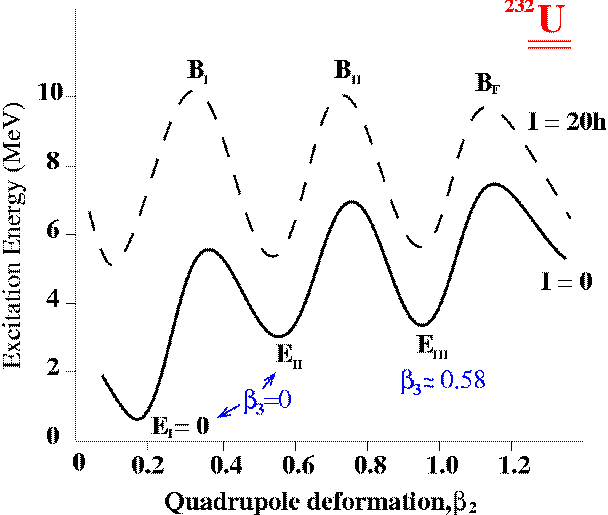
in Uranium Isotopes |
This work was presented by D. Hawcroft at the XXXIII Zakopane School of Physics 1998.
Actinide nuclei possess significant Octupole deformations.
Predicted to possess Low lying SUPERDEFORMED (SD) and HYPERDEFORMED (HD) minima.

TRS calculations predict the HD minima in Uranium isotopes to have a large OCTUPOLE component.
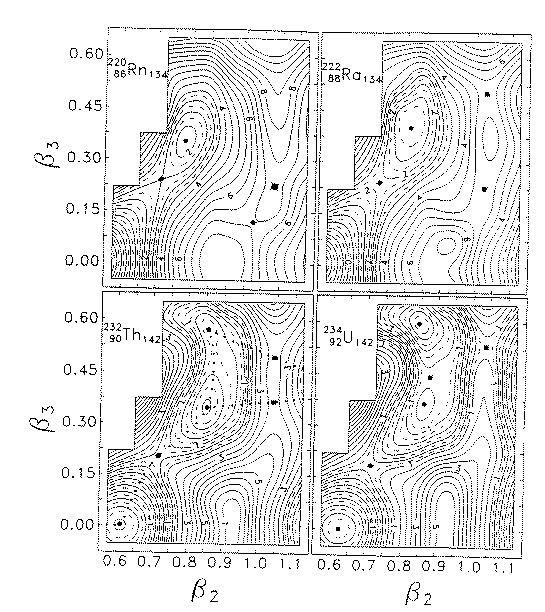
S. Cwiok et al, Phys. Lett. B322 (1994) 304.
232Uranium has 92 protons and 140 neutrons and is predicted to have a "dinuclear" shape.
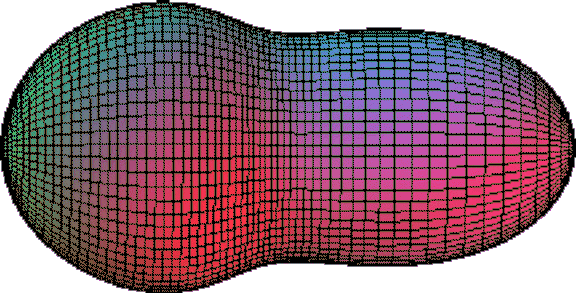
nearly spherical heavier component (around doubly-magic 132Sn)
well-deformed lighter component (from the neutron-rich A ~ 100 region)
of hyperdeformation |
Octupole deformed  interleaved levels of positive and
negative parity which will decay strongly through E1 emission
interleaved levels of positive and
negative parity which will decay strongly through E1 emission
low energy gamma-rays (Energies from 50 to 150keV)
E2's strongly converted
look for E1's  regularly spaced gamma-rays,
energy spacing ~ 5keV
regularly spaced gamma-rays,
energy spacing ~ 5keV
| HD states | Fission | |
| Mean Gamma Multiplicity | 15 | 10 |
| Gamma Energy | 100 keV | 1 MeV |
| Detection Efficiency | 11% | 1% |
| Cross section | 10 microbarns | 1 barn |
high efficiency at low energy .... AFRODITE |
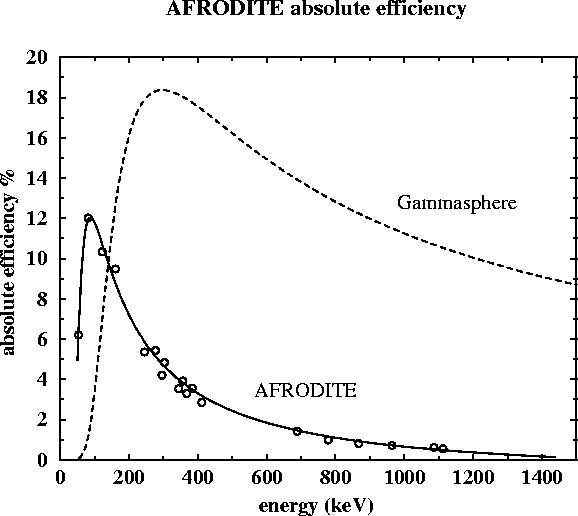

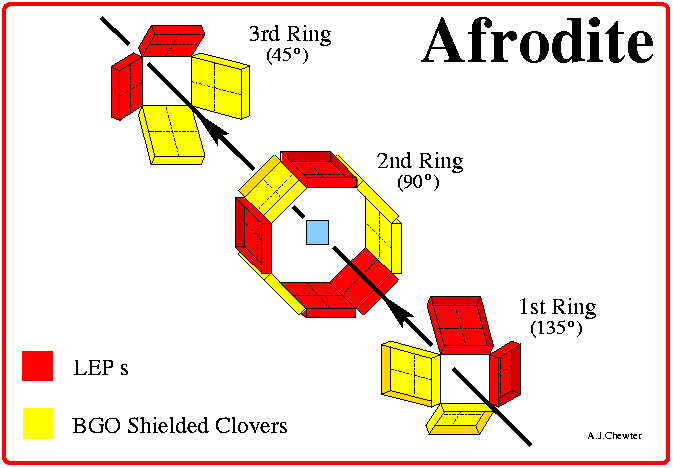
232Th( ,4n)232U with a beam
energy of 40 MeV
,4n)232U with a beam
energy of 40 MeV
Target thickness 2mg/cm2.
Collected 5 x 108 four fold and higher events.
Data was sorted into a
 -
- -
-
 cube.
cube.
Using the predicted  -ray energies as a starting point, a
large number of gate lists were produced by slightly varying the moment
of inertia of the deformed nucleus.
-ray energies as a starting point, a
large number of gate lists were produced by slightly varying the moment
of inertia of the deformed nucleus.
Each of these gate lists were applied to the cube.
However, no clear evidence for the existence of a hyperdeformed band was seen.
In order to test the sensitivity of the experiment a Monte Carlo simulation was carried out.
An assumed hyperdeformed band was populated at a varied fraction ranging from 0.5 to 5 percent of the ground state (yrast) band population.
The resulting
gamma cascades were corrected for internal conversion and the
spectrometer response was folded in. The background was modelled
empirically to reproduce the experimental background in the
 -
- -
- cube.
cube.
The top figure below shows the experimental ground state band brought back from a sum of gates on the labelled transitions.
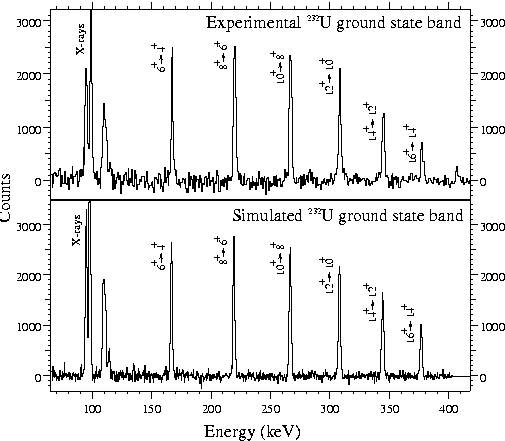
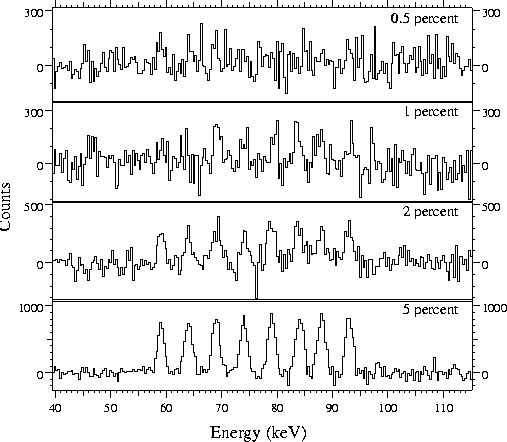
An experiment was performed using the AFRODITE array to search for the existence of a rotational band built on the hyperdeformed minimum in the 232U nucleus.
No clear evidence for the existence of a hyperdeformed band was seen.
It was found through Monte Carlo Simulations that at a population level of 0.5 to 1.0 percent the experiment is no longer sensitive enough to pick out the signal of the hyperdeformed band from the background.
D. Hawcroft1, D. E. Appelbe1, D. G. Aschman2, B. R. S. Babu3, R. Bark4, R. Beetge2, M. Benatar2, P. A. Butler1, A. J. Chewter1, G. D. Dracoulis4, R. Fearick2, S. V. Fortsch3, R.-D. Herzberg1, G. D. Jones1, S. Juutinen5, H. Kankaanpää5, J. J. Lawrie3, G. K. Mabala2, N. Mhlahlo2, S. Murray2, S. Naguleswaran3, D. P. Rea1, C. Rigollet3, J. F. Sharpey-Schafer3, B. Simpson3, R. Smit3, D. Steyn2, V. M. Tshivhase2 and W. Whittaker2.
1 Oliver Lodge Laboratory, University of Liverpool, Liverpool, L69 3BX, United Kingdom.
2Department of Physics, University of Cape Town, South Africa.
3National Accelerator Centre, Faure, 7131, South Africa.
4Australian National University, Canberra, ACT 0200, Australia.
5Department of Physics, University of Jyväskylä, FIN-40351, Jyväskylä, Finland.
Last modified: 4 February 1999
Written by Debs Hawcroft, dh@ns.ph.liv.ac.uk